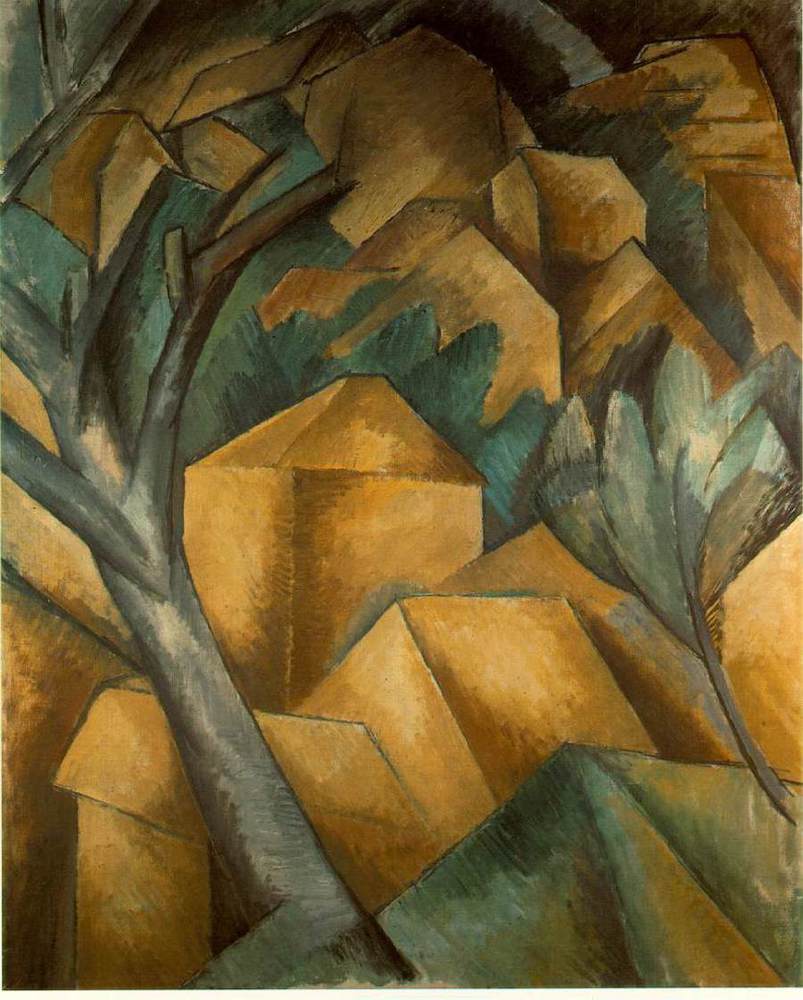Outcome
Artist
Georges Braque was a French painter, collagist
and sculptor. His earlier works focused mainly on landscapes, whereas later he
started to paint still life. As the avant-garde of Cubism, his style was
characterized by the abstraction, faceting and fragmentation of the objects. Also,
he always adopted very limited colors and hues in order to emphasize the
subject of his paintings. Braque contributed greatly to the development of
Fauvism and Cubism, and his works were deeply influenced by Paul Cézanne, an
influential Post-Impressionist painter.
Work
Houses at l’Estaque (see below), an oil painting by Georges Braque in 1908, is considered as the first Cubist landscape. The painting was a response to works by Paul Cézanne, who was Braque’s idol and lived in L’Estaque for a period of time. This work itself was also influenced by Cézanne’s style, as Braque painted the houses and trees from multiple perspectives instead of a unifying one, and therefore we cannot find a vanishing point in this painting like we often do. Braque also simplified both the forms and the use of colors. He reduced an architectural structure to a geometric form approximating a cube, yet rendered its shading so that it looked both flat and three-dimensional by fragmenting the image (1); he also adopted a monochromatic palette of mainly ochre, brown, dark green and grey in this painting to create a non-naturalistic tone. His Cubism style gave each object in this scene a comprehensive description, no matter whether this object was in the front or in the back.
Approach
From my point of view, the most interesting and significant feature of this painting is Braque’s use of multiple perspectives. This feature gives me the feeling that the subjects in the painting are simply stacked on top of each other, without an obvious distinction between the foreground and the background. Therefore, I use Photoshop to create a puzzle, or collage version of this painting, in order to show its unique style of fragmentation and flatness. Also, I use the animation tool in Photoshop to make it a gif, which helps to demonstrate how Braque unites dissected parts from different perspectives to form a complete landscape.
Product
My reproduction of Goerges Braque’s Houses at
l’Estaque is an animated version in collage style. I used Photoshop to segregate
the painting into five different parts, each part containing a group of houses,
trees or any abstract cubes. I animated them with a 0.5 second interval between
any two frames to show the process of composing the “collage”. Also, in order
to imitate Braque’s style of preferring flatness to depth, I intentionally
randomized the order of these five parts in the gif, that is, I did not add
them from foreground to background orderly.
Reflection
I think I effectively captured the style of the work, by emphasizing the core concepts of Proto-Cubism: multiple perspectives and fragmentation. However, since Houses at l’Estaque is one of the most influential paintings of Proto-Cubism, it conveys numerous significant ideas in the 20th century such as abstraction and monochromatic palette those I did not illustrate in my reproduction other than the concept of multiple perspectives. I would like to illustrate these ideas if given the opportunity to do so.
From the process of my reproduction, I learned that digital reproduction could be a very powerful media for canvas masterpieces. For example, when I was producing the animation, I realized that for non-experts in art like me, moving figures in a gif could be more convincing than static painting to illustrate what is “fragmentation” in Cubism.
References:
You can upload files of up to 20MB using this form.
